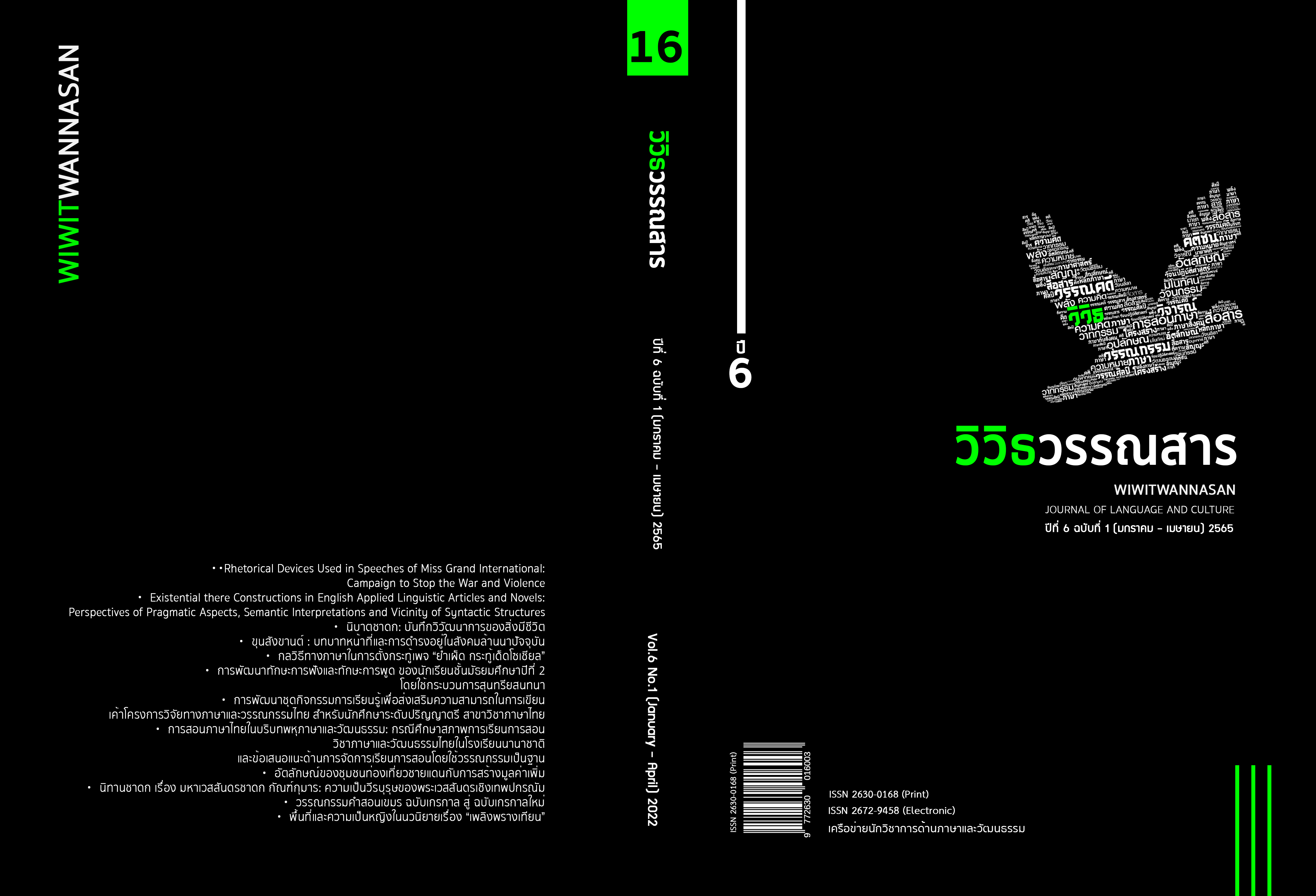อัตลักษณ์ของชุมชนท่องเที่ยวชายแดนกับการสร้างมูลค่าเพิ่ม
Main Article Content
บทคัดย่อ
การวิจัยครั้งนี้มีวัตถุประสงค์เพื่อศึกษาอัตลักษณ์ของอำเภอนาตาล และการนำอัตลักษณ์ดังกล่าวมาสร้างมูลค่าเพิ่ม โดยใช้กลุ่มตัวอย่างผู้มีส่วนได้ส่วนเสียทางการท่องเที่ยวของอำเภอนาตาล จังหวัดอุบลราชธานี ดังนี้ ภาครัฐบาล 8 คน ภาคเอกชน 6 คน และภาคชุมชน 4 คน ใช้แบบสัมภาษณ์แบบมีโครงสร้าง และแบบประชุมกลุ่มย่อยในการรวบรวมข้อมูล มีการสุ่มตัวอย่างแบบไม่อาศัยความน่าจะเป็น ด้วยการสุ่มตัวอย่างแบบเฉพาะเจาะจง วิเคราะห์ข้อมูลโดยใช้แนวคิดทฤษฎีด้านคติชนวิทยา และด้านการท่องเที่ยวมาจัดกระทำข้อมูลด้วยการวิเคราะห์เชิงเนื้อหา
ผลการศึกษาพบว่าอัตลักษณ์ของอำเภอนาตาล จำแนกเป็น อัตลักษณ์ด้านสิ่งแวดล้อมตามธรรมชาติ คือ หาดชมดาว อัตลักษณ์ด้านสิ่งแวดล้อมที่มนุษย์สร้างขึ้น คือ วัดปากแซง วัดภูถ้ำทอง วัดโนนสว่าง ถ้ำตาลาว และอัตลักษณ์ด้านวิถีชีวิต ได้แก่ อาหาร ที่อยู่อาศัย การแต่งกาย อาชีพ และประเพณี ความเชื่อ ศิลปะพื้นบ้าน การนำอัตลักษณ์ของอำเภอนาตาลมาสร้างมูลค่า เป็นการนำทุนชุมชนที่มีศักยภาพมาสร้าง/เพิ่มมูลค่าผ่านสินค้าทางการท่องเที่ยว จำแนกเป็น 1) กิจกรรมการท่องเที่ยวทั้งทางธรรมชาติและการท่องเที่ยวทางศาสนา และวัฒนธรรม เช่น การชมความงามของแก่งหิน การดูวิถีชีวิตของผู้คนริมน้ำโขง โดยมีมัคคุเทศก์น้อยเป็นผู้ให้ข้อมูล การไหว้พระ การทำบุญปล่อยปลา และการชมความงามของลำน้ำโขงที่ผันแปรตามช่วงฤดู 2) ของฝาก/ของที่ระลึก โดยจะเน้นการนำผ้าฝ้ายย้อมครามมาสร้างมูลค่า นอกเหนือจากนี้ยังสามารถพบเห็นสินค้าแปรรูป เช่น เผือกฉาบ มันฉาบ เป็นต้น
Article Details

อนุญาตภายใต้เงื่อนไข Creative Commons Attribution-NonCommercial-NoDerivatives 4.0 International License.
ลิขสิทธิ์ของบทความเป็นของวารสาร การพิมพ์ซ้ำจะต้องได้ร้บการอนุญาตจากบรรณาธิการวารสาร
เอกสารอ้างอิง
Ban Huai Kon, Amphoe chaloem Phrakiat, Changwat Nan. (Master’s thesis). Chulalongkorn University, Bangkok.
Community Development Department. (2018). Operational Mobilization of OTOP Nawatwithi’s Tourism Community. E BOOK.
Department of Highways. (2018). Suitability Study of Economic, Engineering and Environmental Impact and Explore the Network of 6th Thai-Lao Friendship
Bridge (Ubon Ratchathani – Salavan). Documentation of the Meeting on Preventive, Remedial and Environmental Impact Reduction (Subgroup No. 2)
ESAN INFORMATION @UBON RATCHATHANI. (2021, July, 15). Wat Phra To. Retrieved from http://www.esanpedia.oar.ubu.ac.th/esaninfo/?p=2929
Jankaew, B. (2015). The study of Border Tourism Potential, Chiang Khong District, Chiang Rai Province. (Master’s thesis). Maejo University, Chiang Mai.
Janruang, J., Weerotpadungpong, N., Chimngamsert, C., Meesawadikul, W., Rattanaprayoon, S., Wanawat, B., Faiikhoksung, P., Panyayong, W.,
Kongkhaow, P., Thammayom, A., Mean, S., (2019). Adding Value to Cultural Tourism: Exploring Ways to Increase Tourism’s Impact with Community Resources
along Khmer Civilization in The Southern Isan-Cambodia (Phimai-Angkor Wat/Angkor Thom). Thailand Science Research and Innovation (TSRI).
Jaruwon, P. (2016). Folklore and Tourism: Nong Khao Cultural Village, Kanchanaburi Province. Bangkok: Chulalongkorn University Press.
Jearamas, S. (2020). The High Value of Natan: The southern sheriff tells the story of Northeastern Region. Ubon Ratchathani: Yongsawat Intergroup Co., Ltd.
Khowdee, S. (2016). Sandonta Ancestor Worship Tradition of Changwat Surin: The Construction of an Invented Tradition and Role. Bangkok: Chulalongkorn
University Printing.
Nathalang, S. (2020). “Creative Folklore”: A Review of Its Social Context and Related Concepts. Journal of Letters Volume 42 Number 2 (July-December 2013)
Faculty of Arts, Chulalongkorn University. Bangkok.
______. (2016). “Creative Folklore”: Synthesis and theory. Princess Maha Chakri Sirindhorn Anthropology Centre (Public Organization). Bangkok.
Niruthrakul, Y. (2011). Creative Economy. eTAT Tourism Journal. Vol. 4 No.2 April-June 2011.
Sujachaya, S. (2013). Cultural Capital and Today’s Sacred Objects. Journal of Letters Volume 42 Number 2 (July-December 2013) Faculty of Arts, Chulalongkorn
University. Bangkok.
Sirivejjabhandu, A. (2019) Tourism Identity and Marketing in the Special Economic Zone (SEZ): Case Study of Northeast Thailand and Central Laos. Sisaket Rajabhat
University Journal, 13 (1), January-April 2019.
The Fine Arts Department. (2017). Training Materials for Interpreters at Archaeology Information Center of Si Khun Village, Phang Khen Subdistrict, Na Tan
District, Ubon Ratchathani. (Network Project to Conserve Archaeological Sites and Establish Si Khun Village Learning Center) 25-26 August 2019.


